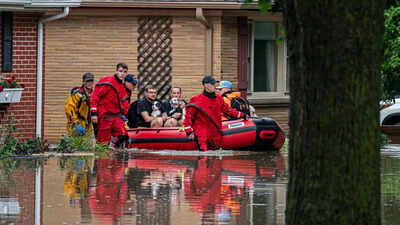ARTICLE AD BOX

Milwaukee suffered a dangerous natural calamity this past weekend, as relentless downpours unleashed sudden, life-threatening flash flooding across the city. With over 10 inches of torrential rain falling within hours, streets turned into rivers, highways were overwhelmed, and vehicles were submerged, and the renowned Wisconsin State Fair was forced to close early for two days.
Emergency services responded to hundreds of distress calls, while power outages and property damage mounted. Residents were urged to stay indoors as power outages and stranded vehicles added to the chaos.But why such chaos due to a flood?Because of the nature of the flood, it’s not a regular flood; it’s a flash flood. Unlike slower, more predictable floods, flash floods strike fast and with little warning, leaving little time for preparation and posing unique dangers to life and infrastructure.
Milwaukee's flash flood: What happened?
Over the weekend of August 9-10, Milwaukee and much of Southeast Wisconsin were battered by torrential rainfall; some areas recorded over 10 inches of rain in a very short span. Rainfall estimates varied, with one report citing up to 14 inches in parts of the metro area. These extraordinary levels turned city streets into waterways, trapped fairgoers at the Wisconsin State Fair, and submerged vehicles in high waters.
As a result, Fair Park shut down operations for a second day, canceling headline events, including a Lynyrd Skynyrd concert, and stranding thousands. Residents described wading through “waist-high” water to escape, while some cars were seen floating through neighborhoods.Emergency services fielded over 600 calls for rescues and flooding-related incidents. Rivers, especially the Menomonee, overflowed and submerged adjacent areas, prompting public officials to urgently advise residents to avoid flooded zones.Milwaukee’s mayor declared a state of emergency, noting extensive property damage, widespread power outages, and vehicles destroyed by flooding. The situation remained fluid as more storms moved into southwestern Wisconsin.

Flash flood vs. regular flood: What’s the difference
What is a Flash Flood?A flash flood is a sudden, intense flood event occurring within six hours or less after heavy rainfall, or due to a dam collapse or rapid snow/ice melt. These floods are marked by fast-moving torrents of water that overwhelm streams, low-lying areas, and dry channels.
The danger lies in the speed and force: risks include rapidly rising water levels, debris flow, and very limited reaction time.What is a regular (river or areal) flood?Regular flooding typically results from prolonged rainfall, snowmelt, or gradual river overflow and develops over days or weeks, not hours. These floods spread over wide areas and are slower to form, which gives residents and authorities more time to evacuate or prepare. Property damage is often high, but the risk to life is generally less immediate compared to flash floods.
Why the difference matters
Flash floods demand quick action. Warning times are short, so Flash Flood Warnings are issued when flooding is imminent or already happening, often less than six hours after the rain begins. In contrast, Flood or Areal Flood Warnings come with more lead time and signal longer-term buildup.In Milwaukee’s case, the sudden, record-breaking rainfall triggered a flash flood, leaving minimal time to respond, which turned fairgrounds, roads, and basements into perilous zones of rapidly rising water.
Looking ahead
Milwaukee’s weekend disaster highlights how vulnerable urban areas can be to flash flooding, especially when intense rain overwhelms drainage systems and hard, paved surfaces accelerate runoff.To reduce risks, authorities and residents should:Monitor flash flood alerts from the National Weather Service and understand the difference between watches and warnings.Avoid driving through flooded roads; just a few inches of moving water can sweep a vehicle away.Improve infrastructure and planning to manage sudden deluges and ease drainage stress.Understanding the contrast between flash floods (fast, furious, and fatal) and regular floods (slower and often more manageable) is key to staying safe when skies open fast and hard.
Uttarkashi Cloud Burst: 10+ Indian Soldiers Missing As Spine-Chilling Flash Flood Wreaks Havoc



.png)
.png)
.png)
















 1 hour ago
5
1 hour ago
5










 English (US) ·
English (US) ·